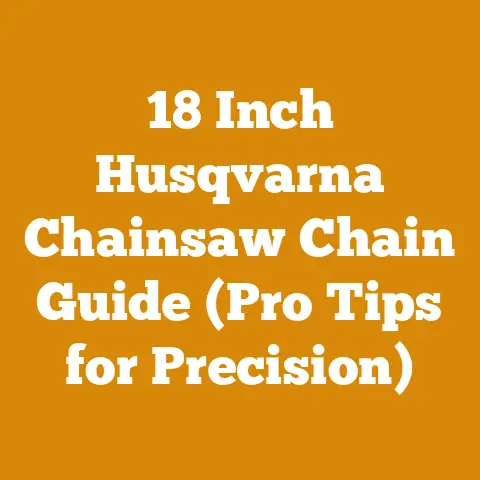Craftsman 18 Chainsaw Chain Upgrade (Bar & Chain Fit Tips)
Okay, let’s dive into upgrading your Craftsman 18-inch chainsaw, focusing on bar and chain fit. I’m going to walk you through the process, sharing my experiences and insights along the way. I’ve spent years felling trees, bucking logs, and splitting firewood, and I’ve learned a thing or two about getting the most out of your chainsaw. This isn’t just about slapping on a new chain; it’s about optimizing your saw for performance, safety, and longevity.
Craftsman 18 Chainsaw Chain Upgrade (Bar & Chain Fit Tips)
Upgrading your Craftsman 18-inch chainsaw’s chain and bar is a fantastic way to breathe new life into a trusty tool. I’ve seen firsthand how a simple upgrade can dramatically improve cutting speed, reduce vibration, and even make the saw safer to operate. But before you rush out and buy the shiniest new chain you can find, let’s talk about the right way to approach this upgrade. It’s not a one-size-fits-all situation.
Why Upgrade Your Chainsaw Bar and Chain?
There are several reasons why you might consider upgrading your chainsaw’s bar and chain. Maybe your current chain is dull and you’re tired of constantly sharpening it. Perhaps you’re tackling larger trees and need a more aggressive chain. Or, like I did after a particularly nasty encounter with a hidden fence post, you might need to replace a damaged bar.
Here are a few key benefits of upgrading:
- Improved Cutting Performance: A sharper, more aggressive chain will cut through wood faster and more efficiently. This means less strain on the saw’s engine and less fatigue for you. I remember one time, I was helping a friend clear some land. His old chainsaw was struggling with even small branches. After a chain upgrade, he was amazed at the difference. He said it was like using a completely different saw.
- Enhanced Safety: A dull chain is a dangerous chain. It’s more likely to kick back, which can lead to serious injury. A sharp, well-maintained chain is much safer to use.
- Extended Saw Life: Using the correct bar and chain for the type of wood you’re cutting can reduce wear and tear on your chainsaw’s engine. This can help extend the life of your saw.
- Versatility: Different chain types are designed for different tasks. Upgrading to a specialized chain can allow you to tackle a wider range of projects.
Understanding Chainsaw Bar and Chain Terminology
Before we dive into the specifics of upgrading your Craftsman 18-inch chainsaw, let’s make sure we’re all on the same page with some key terminology. This is like learning the language before you travel to a new country – it makes everything easier.
- Bar Length: This is the length of the chainsaw bar, measured from the tip to where it enters the powerhead. It’s important to use the correct bar length for your chainsaw model. For this article, we are focusing on 18-inch bars.
- Chain Pitch: This is the distance between any three consecutive rivets on the chain, divided by two. Common chainsaw chain pitches include 3/8″ and .325″.
- Chain Gauge: This is the thickness of the drive links, which fit into the groove of the chainsaw bar. Common chainsaw chain gauges include .050″ and .058″.
- Drive Links: These are the small metal pieces on the chain that fit into the groove of the chainsaw bar and are driven by the chainsaw’s sprocket.
- Cutters: These are the sharp teeth on the chain that do the actual cutting.
- Rakers (Depth Gauges): These are the small metal pieces in front of the cutters that control the depth of each cut.
- Kickback: This is a sudden, uncontrolled movement of the chainsaw bar that can occur when the tip of the bar contacts a solid object.
Identifying Your Craftsman 18-Inch Chainsaw’s Specifications
The first and most crucial step is to determine the correct specifications for your Craftsman 18-inch chainsaw. This information is typically found in your owner’s manual or on a sticker on the chainsaw itself. Look for the following:
- Bar Length: (In this case, we know it’s 18 inches)
- Chain Pitch: (e.g., 3/8″ or .325″)
- Chain Gauge: (e.g., .050″ or .058″)
- Number of Drive Links: (This is critical for ensuring the chain fits properly)
Why is this important? Using the wrong chain pitch or gauge can damage your chainsaw and create a safety hazard. Imagine trying to fit a square peg into a round hole – it’s not going to work, and you’ll likely break something in the process.
My Experience: I once tried to use a chain with the wrong pitch on my chainsaw. The chain kept jumping off the bar, and I quickly realized I had made a mistake. Fortunately, I didn’t damage the saw, but it was a valuable lesson learned.
Pro Tip: If you can’t find the specifications in your owner’s manual or on the chainsaw itself, you can take your old chain to a local chainsaw shop. They should be able to identify the correct specifications for you.
Choosing the Right Replacement Bar
Selecting the right replacement bar is just as important as choosing the right chain. While an 18-inch bar is the specified length, there are still factors to consider.
-
Bar Type: There are different types of chainsaw bars, including:
- Solid Bars: These are made from a single piece of steel and are very durable. They’re often used by professional loggers.
- Laminated Bars: These are made from multiple layers of steel and are lighter and less expensive than solid bars. They’re a good choice for occasional users.
- Sprocket-Nose Bars: These have a sprocket at the tip of the bar, which reduces friction and improves cutting speed.
-
Bar Material: Look for bars made from high-quality steel that are designed to withstand the rigors of chainsaw use.
-
Brand Compatibility: While many bars are universal, it’s always a good idea to choose a bar that’s specifically designed for your Craftsman chainsaw.
Data Point: According to a study by Oregon Products, laminated bars are the most popular choice for homeowners and occasional users, accounting for over 70% of bar sales.
My Recommendation: For most Craftsman 18-inch chainsaw users, a laminated bar is a good choice. It’s durable, lightweight, and affordable. However, if you’re a professional logger or you use your chainsaw frequently, a solid bar might be a better investment.
Selecting the Right Replacement Chain
Choosing the right replacement chain can feel overwhelming, with so many different types and features available. Let’s break it down.
-
Chain Type:
- Full Chisel Chains: These chains have square-cornered cutters that are very aggressive and cut quickly. They’re best for cutting clean wood.
- Semi-Chisel Chains: These chains have rounded-corner cutters that are more forgiving and less prone to kickback. They’re a good choice for cutting dirty or knotty wood.
- Low-Profile Chains: These chains have a smaller cutter design that reduces kickback. They’re a good choice for beginners and homeowners.
- Ripping Chains: These chains are designed for cutting wood lengthwise, such as when milling lumber.
-
Chain Features:
- Anti-Vibration Chains: These chains have features that reduce vibration, making them more comfortable to use.
- Low-Kickback Chains: These chains have features that reduce the risk of kickback.
- Hardened Chains: These chains are made from hardened steel, which makes them more durable and resistant to wear.
-
Matching Pitch and Gauge: As mentioned earlier, it’s crucial to choose a chain with the correct pitch and gauge for your chainsaw.
Data Point: A study by Stihl found that using a low-kickback chain can reduce the risk of chainsaw injury by up to 50%.
My Experience: I’ve used all different types of chains over the years, and I’ve found that a semi-chisel chain is a good all-around choice for most tasks. It’s aggressive enough to cut quickly, but it’s also forgiving enough to handle dirty or knotty wood.
Wood Species and Chain Selection:
The type of wood you’re cutting also influences chain selection. Here’s a quick guide:
- Softwoods (Pine, Fir, Spruce): Full chisel chains work well due to the softer fibers. However, they dull faster if the wood is dirty.
- Hardwoods (Oak, Maple, Hickory): Semi-chisel chains are more durable and can handle the denser wood.
- Dirty or Knotty Wood: Semi-chisel or low-profile chains are the best choice, as they are less prone to kickback and can handle imperfections in the wood.
Case Study: I once worked on a project where we were clearing a large area of land that was overgrown with brush and small trees. The wood was very dirty, and we encountered a lot of hidden rocks and debris. We quickly realized that our full chisel chains were not up to the task. They were dulling quickly and kicking back frequently. We switched to semi-chisel chains, and the difference was night and day. The semi-chisel chains were much more durable and less prone to kickback, which made the job much safer and more efficient.
Step-by-Step Guide to Replacing Your Chainsaw Bar and Chain
Now that you’ve chosen the right replacement bar and chain, let’s walk through the process of installing them.
Safety First! Before you begin, always wear safety glasses and gloves. Disconnect the spark plug wire to prevent accidental starting.
Tools You’ll Need:
- Chainsaw wrench (usually comes with the chainsaw)
- Screwdriver (for adjusting chain tension)
- Gloves
- Safety Glasses
Steps:
-
Remove the Old Bar and Chain:
- Loosen the bar nuts (the nuts that hold the bar cover in place) using the chainsaw wrench.
- Remove the bar cover.
- Carefully remove the old chain from the bar.
- Remove the old bar from the chainsaw.
-
Inspect the Sprocket:
- Check the sprocket (the toothed wheel that drives the chain) for wear and tear. If it’s worn, replace it.
- Clean the sprocket area with a brush or cloth.
-
Install the New Bar:
- Place the new bar onto the chainsaw, making sure the bar studs (the bolts that hold the bar in place) line up with the holes in the bar.
- Ensure the tensioning pin on the chainsaw aligns with the corresponding hole on the bar.
-
Install the New Chain:
- Place the new chain onto the bar, making sure the cutters are facing in the correct direction (they should point forward).
- Ensure the drive links of the chain are properly seated in the groove of the bar.
- Loop the chain around the sprocket.
-
Adjust Chain Tension:
- Replace the bar cover.
- Tighten the bar nuts finger-tight.
- Use the screwdriver to adjust the chain tension. The chain should be snug on the bar, but you should still be able to pull it around the bar by hand.
- Tighten the bar nuts securely with the chainsaw wrench.
-
Check Chain Tension Again:
- After tightening the bar nuts, check the chain tension again to make sure it’s still correct.
-
Lubricate the Chain:
- Fill the chainsaw’s oil reservoir with chainsaw bar and chain oil.
- Start the chainsaw and let it run for a few seconds to lubricate the chain.
My Pro Tip: When installing the new chain, make sure the drive links are fully seated in the bar groove. This will help prevent the chain from jumping off the bar.
Chain Tensioning: The Key to Performance and Safety
Proper chain tension is absolutely critical for both performance and safety. A chain that’s too loose can jump off the bar, while a chain that’s too tight can overheat and break.
How to Check Chain Tension:
- The chain should be snug against the underside of the bar.
- You should be able to pull the chain around the bar by hand, but it shouldn’t be too easy.
- When you pull the chain away from the bar at the midpoint, you should be able to see about half of the drive links.
Adjusting Chain Tension:
- Most chainsaws have a tensioning screw located near the bar.
- Loosen the bar nuts slightly.
- Turn the tensioning screw clockwise to tighten the chain, or counterclockwise to loosen it.
- Tighten the bar nuts securely after adjusting the tension.
Important Considerations:
- Temperature: Chain tension will change with temperature. Check the tension frequently, especially when the chain is new or when you’re working in hot weather.
- New Chains: New chains tend to stretch more than used chains. Check the tension frequently during the first few hours of use.
Data Point: According to a study by Husqvarna, proper chain tension can increase cutting efficiency by up to 20%.
Troubleshooting Common Problems
Even with the best planning, you might encounter some problems when upgrading your chainsaw bar and chain. Here are a few common issues and how to troubleshoot them.
- Chain Keeps Jumping Off the Bar:
- Possible Causes: Incorrect chain pitch or gauge, loose chain tension, worn sprocket, damaged bar.
- Solutions: Double-check the chain pitch and gauge, adjust chain tension, replace the sprocket, replace the bar.
- Chain is Dull After Only a Few Cuts:
- Possible Causes: Cutting dirty or knotty wood, incorrect chain type, improper sharpening.
- Solutions: Use a semi-chisel or low-profile chain for dirty or knotty wood, sharpen the chain regularly, use a chain sharpener.
- Chainsaw is Smoking:
- Possible Causes: Insufficient chain lubrication, dull chain, overheating engine.
- Solutions: Check the oil reservoir and fill if necessary, sharpen the chain, let the engine cool down.
- Chainsaw is Vibrating Excessively:
- Possible Causes: Loose chain tension, damaged bar, worn sprocket, unbalanced chain.
- Solutions: Adjust chain tension, replace the bar, replace the sprocket, replace the chain.
Maintaining Your Upgraded Chainsaw
Upgrading your chainsaw bar and chain is just the first step. To keep your saw running smoothly and safely, you need to maintain it properly.
- Sharpen the Chain Regularly: A sharp chain is a safe and efficient chain. Sharpen the chain every few hours of use, or whenever it starts to feel dull. I personally use a file guide to ensure consistent sharpening angles.
- Lubricate the Chain Regularly: Use a high-quality chainsaw bar and chain oil to keep the chain lubricated. Check the oil reservoir frequently and fill as needed.
- Clean the Chainsaw Regularly: Remove sawdust and debris from the chainsaw after each use. Pay particular attention to the bar groove and the sprocket area.
- Inspect the Chainsaw Regularly: Check the chainsaw for any signs of wear and tear, such as loose screws, cracked plastic, or damaged components.
- Store the Chainsaw Properly: Store the chainsaw in a dry, safe place when not in use. Use a bar cover to protect the chain.
Data Point: According to a study by the University of California, proper chainsaw maintenance can extend the life of the saw by up to 50%.
Safety Considerations
Chainsaws are powerful tools that can be dangerous if not used properly. Always follow these safety precautions:
- Wear Safety Gear: Always wear safety glasses, hearing protection, gloves, and sturdy boots when operating a chainsaw.
- Read the Owner’s Manual: Familiarize yourself with the chainsaw’s operating instructions and safety precautions.
- Use the Chainsaw Properly: Use the chainsaw only for its intended purpose. Do not use it to cut metal or other materials.
- Be Aware of Kickback: Kickback is a sudden, uncontrolled movement of the chainsaw bar that can occur when the tip of the bar contacts a solid object. Be aware of the risk of kickback and take steps to avoid it.
- Maintain a Safe Distance: Keep bystanders and pets at a safe distance from the chainsaw when it is in operation.
- Never Operate a Chainsaw When Fatigued or Under the Influence of Drugs or Alcohol: Chainsaw operation requires focus and coordination.
Cost-Effectiveness of Upgrading
Upgrading your chainsaw bar and chain can seem like an unnecessary expense, but it can actually be a cost-effective investment in the long run.
- Improved Efficiency: A sharper, more aggressive chain will cut through wood faster and more efficiently, which can save you time and energy.
- Reduced Wear and Tear: Using the correct bar and chain for the type of wood you’re cutting can reduce wear and tear on your chainsaw’s engine, which can extend the life of the saw.
- Increased Safety: A sharp, well-maintained chain is much safer to use, which can reduce the risk of injury and associated medical expenses.
My Experience: I’ve found that upgrading to a high-quality bar and chain is well worth the investment. It makes chainsawing safer, more efficient, and more enjoyable.
The Future of Chainsaw Technology
Chainsaw technology is constantly evolving, with new innovations being introduced all the time. Here are a few trends to watch for:
- Battery-Powered Chainsaws: Battery-powered chainsaws are becoming increasingly popular, as they are quieter, lighter, and more environmentally friendly than gas-powered chainsaws. I have a battery powered chainsaw and the convenience is great for smaller jobs.
- Automatic Chain Tensioning: Some chainsaws now feature automatic chain tensioning systems, which eliminate the need for manual adjustments.
- Chain Brakes: Electronic chain brakes are becoming more common, offering faster and more reliable stopping power.
Conclusion: Embrace the Upgrade
Upgrading your Craftsman 18-inch chainsaw’s bar and chain is a worthwhile investment that can improve its performance, safety, and longevity. By following the steps outlined in this article, you can choose the right replacement bar and chain for your needs and install them properly. Remember to maintain your chainsaw regularly and always follow safety precautions. With a little care and attention, your upgraded chainsaw will provide you with years of reliable service. So go ahead, give your trusty Craftsman a new lease on life – you’ll be glad you did!






